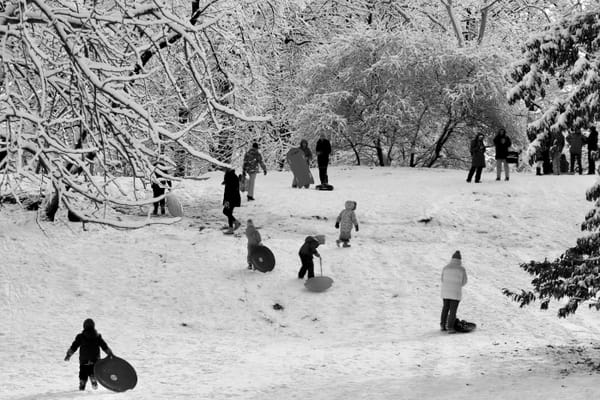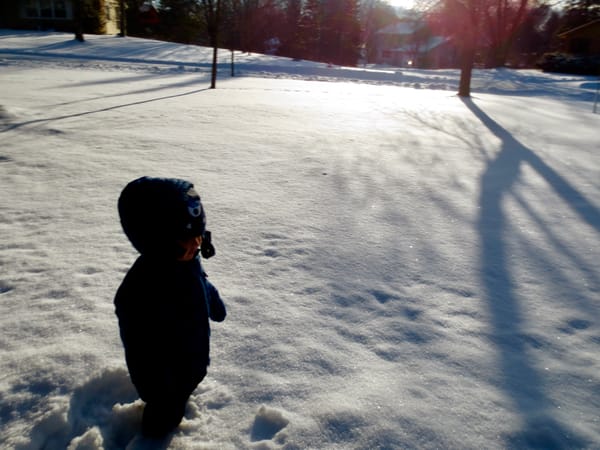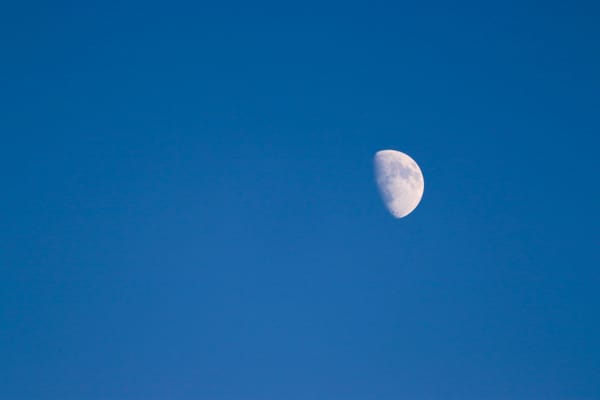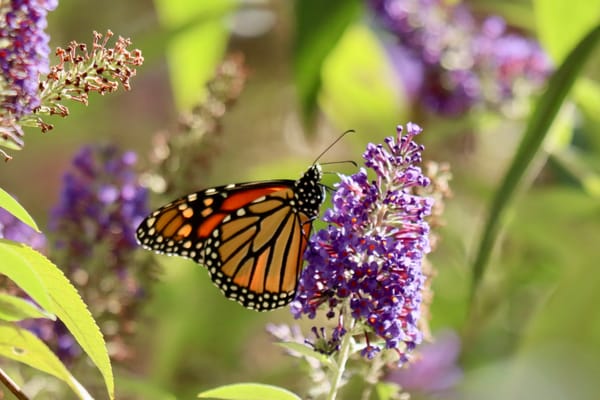Look for Small Sparks of Joy
And use the warmth of these little glimmers as fuel

“Sometimes our best efforts do not go
amiss, sometimes we do as we meant to.
The sun will sometimes melt a field of sorrow
that seemed hard frozen: may it happen for you.”
~Sheenagh Pugh
My son is old enough to walk himself to school these days, but we still walk together most mornings. He no longer needs me to hold his hand as we cross streets. But I think the ritual of starting the day together in this way anchors us both.
We walk along the edge of the park, with the Hudson River rolling by just over our shoulders, the city to one side, the trees and the water to the other. Often, the energy of the dogs on their morning walks is enough, all by itself, to set a lighter tone for the day. There’s an elderly woman who sometimes sits on a particular bench with a bag of walnuts. She sets them out delicately on the edge of the bench for the squirrels, who creep toward her until they’re close enough to grasp a nut wide-eyed, and carry it away like a giant pearl. She also keeps dog treats in her pocket, and there is one dog who jumps straight up into the air when he sees her. He’s not a small dog, and the height he gains from his excitement is both impressive and delightful.
New York is windier than people who don’t live here expect. It’s easy to forget that the city is an island surrounded by waterways. The rivers pull the wild gusts that swirl over the Atlantic along their paths, and the buildings create tunnels for the wind to rush through, as they kiss the sky along the city’s streets and avenues. This winter was especially windy, and at times our morning walk felt like doing battle with an aggressive force, determined to push us back home. Nonetheless, there were only a handful of cold days when my son opted to take the subway instead.
The strong gusts that dominated this winter have made the emergence of warmer air and the first signs of color in the trees especially welcome. Crocuses and daffodils are starting to push through the soil, and there’s a hawk that has been perching in the trees just south of the basketball courts. Last week, he was carrying a long, thin stick, presumably gathering material for a nest somewhere nearby.
At the very beginning of the pandemic, nearly everyone in New York shut themselves inside. Not only in New York, of course. But we were hit early and hard, so the shutdown of the city that never sleeps felt especially sudden and ominous. We listened to the sirens wailing by and stood at our windows each evening cheering on those who drove the ambulances and received their fragile passengers, but we didn’t venture out. Then, as the science began to clarify how transmission occurred, we began to take careful steps back out into our parks, keeping wary distance from each other at first, but grateful for the crisp air, which was just starting to warm with the spring rays of early April. I remember feeling surprised by the bright green leaves beginning to take their place along the tree branches and the flowers starting to dot the hills with hints of color. It felt disjointed for the world to be so frightening and uncertain, while somehow also continuing to renew itself, according to all the usual cycles and rhythms. But it was also a reminder that, even in the midst of dark moments, there are glimmers of beauty and tenacious renewal.
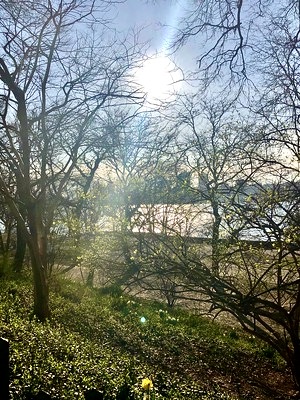
The lesson here is delicate. There is an easy conclusion that’s often drawn from the persistent reawakening of nature, that goodness will always re-emerge if only we are patient enough. But I think this is a precarious lesson, because it is only one logical step from this idea to complacency. In both intimate, personal ways and at the scale of the natural world, very little is guaranteed through waiting alone. Rather, we persist through endurance, which requires active participation and effort. Even the trees and bulbs are not entirely dormant in the winter, as the freezing cycle initiates the trees’ sap production and conservation of nutrients in the roots, and the bulbs rely on the cycles of frost to trigger their spring growth. As with the distinction between optimism, which asks only for our faith, and hope, which demands that we work to bind ourselves to the effort of pulling toward something better, spring does not arrive without effort.
As much of our natural world hovers on the brink, nothing guarantees the arrival of the daffodils and the green leaves each year. These signs of renewal are not signs of inevitability but of persistence. The hawk, perching in the trees along the river, twig in its beak, ready to build a nest, is a particularly notable emblem of this persistence. When I was a child, growing up in New York, hawks were rare. The rivers that surround the city were a toxic soup, the sky was clouded with smog, and the raindrops were acidic. But we worked to rehabilitate the water and the air. And gradually the fish returned, then the sea birds and other aquatic creatures that feed on the fish. Now there are not only hawks but egrets, herons, owls, and bald eagles soaring over the city. They’re here because we fought for them.
Moments of beauty and glimmers of joy, wherever they are found—in nature, in art, in each other—are not promised to us. Rather, they are reminders of what is worth committing to and fighting for and of what we have to lose if we are complacent, not just in nature but in every aspect of our interconnected personal, social, and political lives.
This, I think, is the real lesson of spring and, more broadly, of remembering to fully soak in moments of joy whenever we notice them. They are reminders, not only to take in delight but to be on the lookout for it, because joy is fragile and it is not guaranteed. By seeking joy out, by recognizing it, and by acknowledging its delicacy and impermanence, the significance of the work we have in front of us becomes more visceral and multi-dimensional. Our task is not only to resist cruelty, but to clear the air and fertilize the soil in which joy and beauty and pleasure thrive. So it is important that we take in these sparks of pleasure, as we would a deep breath providing us with the oxygen to keep moving and to keep claiming space for joy and meaning.
If despair leads to paralysis, then the glimmers of beauty, the small pleasures we unearth in the world, and our capacity to connect with one another are the antidote. The deep feeling of relief and gladness that overtakes us in these moments, however fleeting, has the power to re-animate us. Seek these moments out, let them in, and recognize them as the signifiers of the need to persist.

I wrote about the power of joy in one of my first notes, and I quoted Ross Gay there. His words bear repeating, especially now that the stakes of committing to persistent care, interdependence, and solidarity are even more urgent. Gay writes,
“My hunch is that joy is an ember for or precursor to wild and unpredictable and transgressive and unboundaried solidarity. And that that solidarity might incite further joy. Which might incite further solidarity. And on and on. My hunch is that joy, emerging from our common sorrow—which does not necessarily mean we have the same sorrows, but that we, in common, sorrow—might draw us together. It might depolarize us and de-atomize us enough that we can consider what, in common, we love. And though attending to what we hate in common is too often all the rage (and it happens also to be very big business), noticing what we love in common, and studying that, might help us survive. It’s why I think of joy, which gets us to love, as being a practice of survival.”
A powerful element of Gay’s thesis is that even very small moments of consciously noticing and taking in delight can be enough to reignite our sense of meaning, purpose, connection, and agency.
A squirrel grasping the treasure of an oversized nut, a dog leaping impossibly high propelled into the air by happiness, a hawk holding its stick as a promise of the future it will build, “the greening of the trees,” as poet, Ada Limón, says, or the quiet company of the person you love most—all these are sparks, glowing in the world around us, reminding us of the work we have to do and of why it matters.
I once stumbled on a story by the author and educator, Auburn Sheaffer, during an especially dark and scary period in my life. She describes a harrowing and near hopeless chapter in her own life and a chance connection with a stranger, whose willingness to simply listen and show a glimmer of care powerfully shifted her trajectory. Her conclusion has always stuck with me. She says,
“I had experienced that there was random love in the universe and that some of it was unconditional and that some of it was for me. And I can’t tell you that I got my life totally together that day. But it became possible…This is what I know. In the deepest, blackest night of despair and anxiety, it only takes a pinhole of light, and all of grace can come in.”
Over the last few weekends, the poet and writer, Saeed Jones, has been posting a prompt on Bluesky, asking people to share something delightful or joyful that happened during their week. (If you’re not familiar with his work, Jones is someone who understands deeply the seriousness of the challenges we face. But, like Ross Gay, he also has a keen awareness of the power of joy and community.) There’s surely a lot that can be toxic and harmful about social media, and I don’t spend much time there. But I have noticed that the conversations that emerge out of these little prompts seem to be a balm for everyone who enters. And, beyond that, they spark an energy and a sense of connection that feels anything but passive. I’ve even noticed myself becoming more alert to small delights throughout the week, since he initiated these touchpoints for shared joy. As much as internet life can be dangerously isolating, there is something to note here about the communal function of, not merely taking note of joy, but sharing it and hearing of others’ delights. When we make these moments public and share them with each other, we go beyond the solitude of traditional gratitude practices to create spaces for communal pleasure.
It is in this shared pleasure—in being reminded, not only of what brings us joy, but also of the joys of others—that we renew our capacity to value one another and to fight for our collective right to seek and experience joy. This is why, as Gay says, “joy is an ember for or precursor to wild and unpredictable and transgressive and unboundaried solidarity…a practice of survival.”
Surely, there is much to mourn and rage against today. But mourning and rage begin in love. We don’t mourn that which we don’t care about. And we don’t fight for each other, or for the world around us, if we don’t notice and absorb the “pinholes of light” that remind us of all there is worth caring for and protecting.
What small delights did you encounter this week? What small moments or rituals filled you with pleasure and purpose, even briefly? And what will you do next to ensure that these moments don’t lull you into complacency but instead ignite your desire to remain active and engaged and purposeful?
Wishing you glimmers of joy and the determination to protect them for yourself and for others,
Alicia
A few things I found helpful & hopeful this week…
- An executive order led to the cancellation of these student musicians’ scheduled performance with the U.S. Marine Band. So a group of veterans formed a new military band to give them their concert, and 60 Minutes covered it. This was a lovely example of collective care and of numerous people rising to meet the moment well for kids.
- Resistance is alive and well, in case you’ve been told otherwise. Researchers are tracking protests, and there have already been double the number held during the same period in 2017. This is evidence of the sustainable momentum and infrastructure needed to build toward the 3.5% tipping point.
- Teachers are brave! You’ve likely seen coverage of this middle school teacher in Idaho, Sarah Inama, who refused to take down a poster that said, “Everyone Is Welcome Here.” The bravery of teachers doesn’t surprise me, because this is the promise we make to children. As she noted in an interview with Chris Hayes,
“I don’t agree that this is a personal opinion. I feel like this is the basis of public education…As a teacher I would do anything to protect my students. I love all of them unconditionally. We protect them from danger. I would quite literally take a bullet for them, and this is the one small thing I feel like I can do to speak out against this and stand up for them, to protect them from being affected by racist sentiments.”
It is also important to note that the school district’s objection was not to the words alone but, specifically, to the fact that the poster displayed children’s hands in a range of skin tones.
If you think someone else in your life might need some hope, please share. It’s always easier to hold onto hope when we’re not doing it alone.


